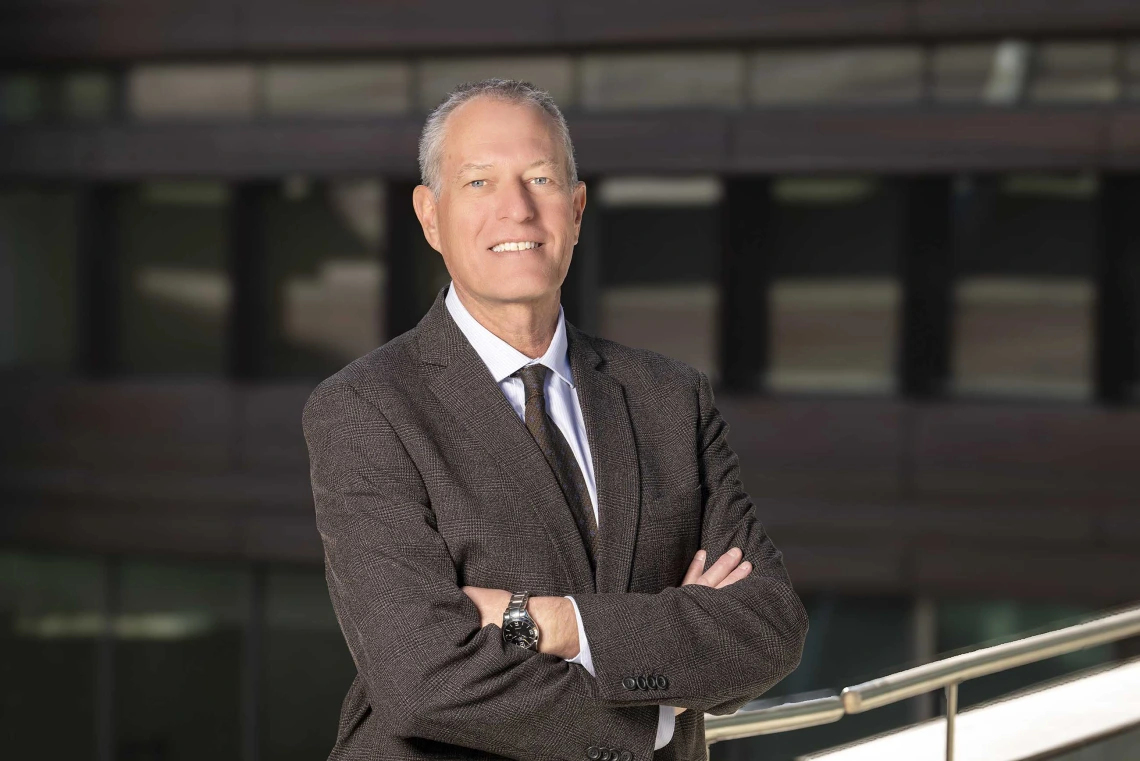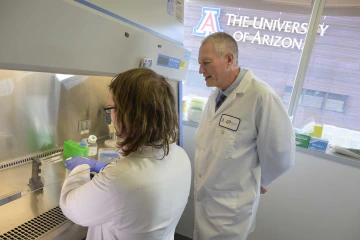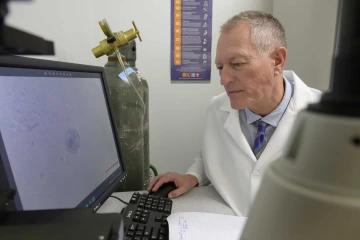Connecting with Frederic Zenhausern, PhD
Phoenix’s nanobioscience leader brings together research from the molecular to the expanse of outer space.

Frederic Zenhausern, PhD, MBA, leads the the Center for Applied NanoBioscience and Medicine at the University of Arizona College of Medicine – Phoenix.
Photo by Noelle Haro-Gomez, U of A Health Sciences Office of Communications
Merging the electrical, mechanical and bioengineering sciences with molecular and cellular biology in medicine, the Center for Applied NanoBioscience and Medicine at the University of Arizona College of Medicine – Phoenix is at the forefront of the evolution of nanoscience, microelectromechanical systems, molecular biology and genomics. Led by Frederic Zenhausern, PhD, MBA, the center is also affiliated with the U of A College of Engineering.
Health Sciences Connect recently caught up with Zenhausern, who is also a member of the BIO5 Institute, to find out what the center is working on, what’s upcoming and how spending time in space impacts the human body.
What are some of the projects your team is currently working on, particularly in developing alternative human models for cancer and radiation studies?

Frederic Zenhausern, PhD, MBA, speaks with Sean Dunn, a graduate research associate in Clinical Translational Sciences, in his lab at the College of Medicine – Phoenix.
Photo by Kris Hanning, U of A Health Sciences Office of Communications
Our portfolio spans a broad range of technologies and applications sponsored by diverse sources from governmental and private organizations. This allows us to guide our discoveries in a “mission driven” approach focusing on practical solutions. For example, we are working on developing alternative human models for cancer and radiation injuries using "body-on-chip" and "organoids" to mimic tissue environments and blood flow. These are used for studying the mechanisms of nanotherapeutics delivery for uveal melanoma treatment, and to study plant-based drug and gene delivery for cancer treatment, for example in lungs or ovaries. Our lung injury models using 3D culture and organ-on-chip enable personalized radio-immunotherapies. These advanced in-vitro technologies provide unprecedented tools for studying the effects of galactic cosmic radiation exposure on astronauts' gut microbiome.
Our latest ASTEROIDS device is mass produced by an industry sponsor and licensee promoting our first pilot studies at early adoption sites in the U.S. and Japan. One study aims to validate the ASTEROIDS device for proton or photon-based FLASH radiation research as an alternative to in-vivo mouse model. Other organ models are also under development including a new ultrasound-transparent model of the blood brain barrier for controlled drug delivery in stroke.
How do the drug delivery methods, from extracellular vesicles and AI-controlled vertical farming to nano-biomaterials for medical gas therapies improve outcomes?
We are working on using extracellular vesicles (human and plant-based exosomes) to improve targeted drug delivery efficiency, including AI-controlled vertical farming methods in collaboration with Biosphere 2, where we also study how climate change affects interactions between immunity and the human microbiome. Our work in nano-biomaterials formulations of "gas marbles" could overcome challenges in medical gas therapies for storing and precisely delivering therapeutic gases, with applications in ischemic diseases, wound healing, and cancer treatment.
How does the VeriFAST system, developed for biological threat detection and clinical diagnostics, work and what makes it adaptable for point-of-care or at-home use?
Over the last three and a half years, under the Defense Threat Reduction Agency Other Transaction Agreement product development contract, we designed and prototyped the VeriFAST system to detect multiple biological threats (Tier 1 pathogens) which now is also adapted to clinical diagnostics for monitoring immune responses in gene therapies. This technology has also been configurated as a point-of-care kit for gene and protein diagnostics that works without any special equipment nor battery power, enabling use at home or in remote locations.
With Arizona State University launching a medical school with an engineering focus in downtown Phoenix, how might that impact your work?
I have over a decade of experience in industry and then at ASU, where I participated in major interdisciplinary programmatic developments. This experience taught me how to build today’s active cooperation based on respective focus of excellence with faculty and institutional leaders at various institutions in the state. I foresee such a partnership will benefit ASU Health, the U of A Health Sciences Center for Advanced Molecular and Immunological Therapies and U of A Bioengineering initiatives in the Phoenix metropolitan area. Our center plays a valuable role in growing the necessary cluster of talents to provide students with outstanding experiential learning, forging the future health economy with improved outcomes for all.
What are some opportunities for collaboration?

Zenhausern’s lab is at the forefront of the evolution of nanoscience, microelectromechanical systems, molecular biology and genomics.
Photo by Kris Hanning, U of A Health Sciences Office of Communications
There are immediate opportunities for nurturing big interdisciplinary and interinstitutional research, leveraging complementary infrastructure in biomanufacturing, such as with CAMI, health technologies and medical devices, as well as in planetary health, such as with Biosphere 2. It will also be important to engage in a collaborative dialogue, enhancing engagement with other clinical and industry stakeholders in the Phoenix metropolitan area. By having both medical schools and state-of-the-art research infrastructure co-located on the Phoenix Bioscience Core, this will create a highly innovative intellectual landscape that will receive significant attention from national but also international companies and investors for stimulating the growth of entrepreneurial outcomes.
Your team developed the OMTEST Platform, derived from your VeriFAST technology, which was deployed on a SpaceX flight. Do you have additional research planned with either SpaceX or with the VeriFAST Platform?
We continue our space research program with the preparation of several scientific publications related to our work performed at the NASA Brookhaven space particles simulator while we have several active and pending grants for developing the vertical flow assay to various clinical applications. Since last November, the VeriFAST system has been validated at the Naval Research Laboratory, while the Defense Threat Reduction Agency has initiated a technology transfer agreement with the Joint Program Executive Office for Chemical, Biological, Radiological and Nuclear Defense for the next phase of product development toward procurement. At the end of March, we will have delivered two prototypes and over 500 kits to the DTRA. We have also started speaking with industry partners to explore commercialization. One patent has been granted while others are still in process.
For the nonengineers, what role does nanobioscience play in space science?
Nanobioscience is well-suited for space applications as some of its intrinsic physical properties are compatible with microgravity conditions. For example, we have developed a machine simulating zero gravity conditions on Earth, which we apply to improve the loading capacity of drugs into lipid nanoparticles to be used as targeted drug deliveries. Under these conditions, mixtures can be achieved without the need for complex chemical or electrophysical manipulation. Another application of interest is the preparation of 3-D cellular constructs (or organoids) in microgravity, which could achieve shapes and speed of reaction difficult under conventional Earth gravity.
What happens at the molecular level when humans spend time in space? How can that be adapted to or planned for on future missions?
Over the last 40 years, there have been a few hundred flights of highly trained and prequalified astronauts. In the last few years, dozens of civilian astronauts have gone to space, and in the next decade, thousands of people will experience the space environment. Today, knowledge of biological effects on human physiology is still limited by the small number of cases, but it is well-known that microgravity impacts bone biology, cognitive functions, vision and immune response to infection. Also, the potential exposure to cosmic radiation could be a significant risk for tissue injuries and cancer. Having access to a large group of individuals going to space will allow us to gain more understanding of biological effects and develop more specific countermeasures. Space exploration will also open opportunities to discover new sources of therapies, such as planetary gaseous components, which might be applicable to health care on Earth.
You participated in the Artist+Research cohort. What was that experience like?
I have been involved in art and science over my entire career. With my team, we have participated in fashion shows, including the Next Fest Wired Magazine exhibit (2004, 2007), and publications like Desert Living Magazine and Lilly Oncology on Canvas. During the last Arts in Medicine event, my team built a large hanging mobile with multiple materials composition from our laboratory and fabrics from a local artist. In 2016, we participated in the creation of a laser light show and lecture at the College of Medicine – Phoenix, which was registered by UNESCO as one of the celebrations of the Year of Light. Art is a crucial part of our team outreach efforts, sharing our passion and enthusiasm for science and social impact.
What is one thing people don’t know about you?
If I have a secret, I will not reveal it now. 😊

